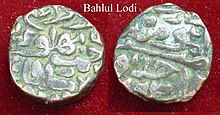Lodi dynasty
The Lodi Dynasty (also Lodhi Dynasty , Urdu : سلطنت لودھی) was founded by Bahlul Lodi (r. 1451–1489), a prince of the Pashtun Lodi tribe .
history
Bahlul Lodi
After the abdication of the last Sayyid sultan, Alam Shah , on April 19, 1451, Bahlul Khan Lodi took over the government of the Sultanate of Delhi . The state was limited to the area around Delhi and was surrounded by independent regional principalities that had broken away from the sultanate's weakening central authority during the reigns of the Tughluq and Sayyid dynasties . Bahlul Khan Lodi did not give up the claim to the territory that once belonged to the great empire of his predecessors. He cooperated with the Afghan nobles by giving them fiefs ( jagir ). Then he forced the rulers of the Doab region under his power. He successfully protected the empire from foreign invasions: twice he repulsed attacks by the Sharqi Sultanate of Jaunpur , then undertook an offensive himself and made Jaunpur a province of Delhi - with his son Barbak Shah as viceroy. Bahlul Khan Lodi ruled for 29 years and died on a campaign in July 1489.
Sikandar Lodi
Nizam Khan, the second son of Bahlul Khan Lodi, was enthroned with the title Sikandar Lodi . He ruled from 1489 to 1517 and proved to be a gifted general, annexing the territories of Bihar and most of the Panjab . In the course of his fight against Gwalior , Sikandar Shah Lodi moved the capital of the Sultanate to Agra, which is strategically located . Delhi continued to be viewed as the sacred center of the empire. A well-functioning administration was established in the core area of Delhi-Agra. Sikandar Lodi was also known as a patron of architecture and other arts. Under his reign the Delhi Sultanate experienced a new heyday. His court attracted many scholars, poets and clergymen, among them the famous Jamali. Translations from Sanskrit into Persian were officially promoted. Sikandar Shah Lodi died on November 21, 1517.
Ibrahim Lodi
His son, Ibrahim Lodi (ruled 1517–1526), became the last sultan of the Lodi dynasty and the Sultanate of Delhi. The time of his reign was marked by division and alienation between the sultan and his vassals. Daulat Khan Lodi , the governor of Panjab, and the sultan's uncle, Alam Khan, conspired with the Timurid ruler Babur of Kabul and encouraged him to campaign in India. Babur took advantage of this opportunity and invaded the Sultanate of Delhi. Ibrahim Lodi was defeated and killed on April 20, 1526 in the First Battle of Panipat ; Delhi and Agra were occupied shortly afterwards. Babur, who was determined to stay in India, became the founder of the Mughal Empire .
Lodi Gardens
Sikandar Lodi was buried in an octagonal mausoleum in the Lodi Gardens of Delhi , opened on all sides by triple arcades and covered by a double-shell and therefore raised dome . The architecture of this building is based strongly on the neighboring tomb for Mohammed Shah IV , about 70 years older , the third sultan of the Sayyid dynasty - it is, however, both spatially and temporally the immediate forerunner of the stylistically very different - now divided into four and symmetrically arranged (paradise) gardens in the Persian style ( Char-Bagh ) - tombs of the Mughal dynasty ( Humayun mausoleum , Akbar mausoleum , Itmad-ud-Daulah mausoleum , Taj Mahal , Bibi-Ka-Maqbara ).
See also
literature
- Hamee-Ud-Din: The Organization of Government under the Lodi Sultans of India. In: Journal of the German Oriental Society , Vol. 110, Harrassowitz, Wiesbaden 1960, pp. 331–341
- Hermann Kulke , Dietmar Rothermund : History of India . Verlag W. Kohlhammer, Stuttgart 1982, ISBN 3-17-007097-5 .
- Ainslie T. Embree, Friedrich Wilhelm: India. History of the subcontinent from the Indus culture to the beginning of English rule . Weltbild Verlag, Augsburg 1998. ISBN 3-89350-989-5 (= Fischer Weltgeschichte, Volume 17)


